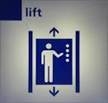题目内容
The world would be a very different place if someone hadn’t invented the lift. There would be few, if any, high-rise buildings because people would refuse to climb many stairs. By the time workers reached their offices on the top floors of a tower building, it would be time to go home – if they were not too tired for the long walk down!

The first lift that we know about was used by the Greek scientist, Archimedes, in about 230 BC. It was a simple place that could be pulled up and down with a rope. A lift like this was used much later in the 12th century by priests who lived on top of a mountain at Metereo in Greece. Because they were afraid of killers, the priests had not built any stairs up the mountain. The only way up was by lift, which priests worked from the top of the mountain.
A few hundred years later, a Frenchman, Villayer, invented a ‘flying chair’ which used a rope and a place. A number of rich people had these ‘flying chairs’ built in their homes, including Queen Anne of England in Windsor Castle and Louis XVI of France at Versailles. Unluckily, Louis’ daughter was badly hurt when using one of the chairs, and Villayer ran away, afraid that he would be punished.
The main problem for lift engineers was that either humans or animals were needed to pull the ropes. This problem was not worked out until the discovery of steam power. But even steam powered lifts were not always safe because they also used ropes which sometimes broke. If the rope broke - which it sometimes did - the lift fell to the ground and people in it were killed or hurt. This problem worked out in 1854 when an American, Elisha Otis, invented something which stopped the lift from falling if the rope broke. At first Otis lifts were used only in factories, then in 1857 he built one in a large New York store. Now lifts use electric power and are completely safe. They also travel very quickly. Some lifts travel faster than 60 kilometers an hour.
小题1:The writer thinks that lifts are important today because __________.
小题2:The 12th century priests had a simple lift instead of stairs because ___________.
小题3:Villayer thought he would be punished because ____________.
小题4:Steam power meant that ________ .

The first lift that we know about was used by the Greek scientist, Archimedes, in about 230 BC. It was a simple place that could be pulled up and down with a rope. A lift like this was used much later in the 12th century by priests who lived on top of a mountain at Metereo in Greece. Because they were afraid of killers, the priests had not built any stairs up the mountain. The only way up was by lift, which priests worked from the top of the mountain.
A few hundred years later, a Frenchman, Villayer, invented a ‘flying chair’ which used a rope and a place. A number of rich people had these ‘flying chairs’ built in their homes, including Queen Anne of England in Windsor Castle and Louis XVI of France at Versailles. Unluckily, Louis’ daughter was badly hurt when using one of the chairs, and Villayer ran away, afraid that he would be punished.
The main problem for lift engineers was that either humans or animals were needed to pull the ropes. This problem was not worked out until the discovery of steam power. But even steam powered lifts were not always safe because they also used ropes which sometimes broke. If the rope broke - which it sometimes did - the lift fell to the ground and people in it were killed or hurt. This problem worked out in 1854 when an American, Elisha Otis, invented something which stopped the lift from falling if the rope broke. At first Otis lifts were used only in factories, then in 1857 he built one in a large New York store. Now lifts use electric power and are completely safe. They also travel very quickly. Some lifts travel faster than 60 kilometers an hour.
小题1:The writer thinks that lifts are important today because __________.
| A.people like playing on them |
| B.they are the best way of using steam power |
| C.we need them for tall buildings |
| D.workers are lazy |
| A.they thought the stairs were broken |
| B.they liked having stairs and a lift |
| C.the lived at the bottom of a mountain |
| D.they were afraid of killers |
| A.poor people could not afford his ‘flying chair |
| B.someone was hurt in one of his ‘flying chairs’ |
| C.his ‘flying chair’ did not work at all |
| D.he ran away with Louis XVI’s daughter |
| A.they did not need a living thing to pull the ropes |
| B.Elisha Otis could invent a lift that would not fall |
| C.the rope always broke |
| D.they could use lifts in factories |
小题1:C
小题2:D
小题3:B
小题4:A
试题分析:这篇短文中作者主要讲述了电梯在日常生活中发挥的重要作用以及电梯的发展衍变过程。
小题1:细节理解题。根据短文There would be few, if any, high-rise buildings because people would refuse to climb many stairs的描述,如果没有电梯,就不可能有那么多的高楼,因为人们不可能爬那么多的楼梯。所以说高楼需要电梯。故选C。
小题2:细节理解题。根据短文Because they were afraid of killers, the priests had not built any stairs up the mountain. The only way up was by lift, which priests worked from the top of the mountain的描述可知,因为害怕被杀,所以牧师使用升降机代替楼梯。故选D。
小题3:细节理解题。根据短文Louis’ daughter was badly hurt when using one of the chairs, and Villayer ran away, afraid that he would be punished的描述可知,因为在使用“飞椅”的过程中,路易斯的女儿严重受损,Villayer以为会被惩罚而逃走。故应选B。
小题4:细节理解题。根据短文The main problem for lift engineers was that either humans or animals were needed to pull the ropes. This problem was not worked out until the discovery of steam power的描述,蒸汽的发明使得升降机不再需要人力或动物拉绳子。故选A。

练习册系列答案
 100分闯关期末冲刺系列答案
100分闯关期末冲刺系列答案
相关题目
